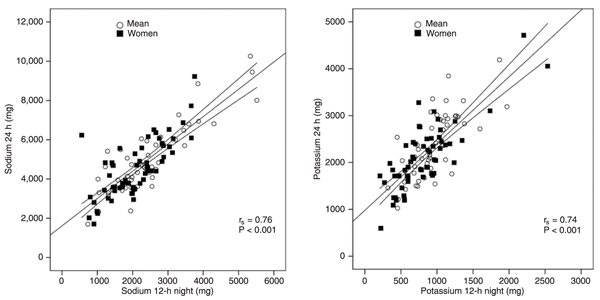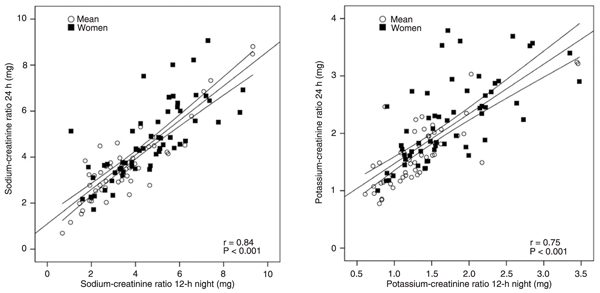Low-sodium and high-potassium diets have been recommended as an adjunct to prevention and treatment of hypertension. Analysis of these nutrients in 24-h urine has been considered the reference method to estimate daily intake of these minerals. However, 24-h urine collection is difficult in epidemiological studies, since urine must be collected and stored in job environments. Therefore, strategies for shorter durations of urine collection at home have been proposed. We have previously reported that collecting urine during a 12-h period (overnight) is more feasible and that creatinine clearance correlated strongly with that detected in 24-h samples. In the present study, we collected urine for 24 h divided into two 12-h periods (from 7:00 am to 7:00 pm and from 7:00 pm to 7:00 am next day). A sample of 109 apparently healthy volunteers aged 30 to 74 years of both genders working in a University institution was investigated. Subjects with previous myocardial infarction, stroke, renal insufficiency, and pregnant women were not included. Significant (P < 0.001) Spearman correlation coefficients (r s) were found between the total amount of sodium and potassium excreted in the urine collected at night and in the 24-h period (r s = 0.76 and 0.74, respectively). Additionally, the 12-h sodium and potassium excretions (means ± SD, 95% confidence interval) corresponded to 47.3 ± 11.2%, 95%CI = 45.3-49.3, and 39.3 ± 4.6%, 95%CI = 37.3-41.3, respectively, of the 24-h excretion of these ions. Therefore, these findings support the assumption that 12-h urine collected at night can be used as a reliable tool to estimate 24-h intake/excretion of sodium and potassium.
Sodium excretion; Urine; Salt intake; Potassium excretion




